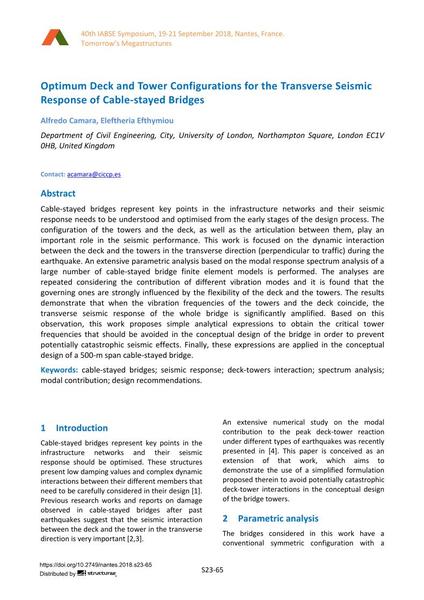Optimum Deck and Tower Configurations for the Transverse Seismic Response of Cable-stayed Bridges

|
|
|||||||||||
Bibliographic Details
| Author(s): |
Alfredo Camara
(Department of Civil Engineering, City, University of London, Northampton Square, London EC1V 0HB, United Kingdom)
Eleftheria Efthymiou (Department of Civil Engineering, City, University of London, Northampton Square, London EC1V 0HB, United Kingdom) |
||||
|---|---|---|---|---|---|
| Medium: | conference paper | ||||
| Language(s): | English | ||||
| Conference: | IABSE Symposium: Tomorrow’s Megastructures, Nantes, France, 19-21 September 2018 | ||||
| Published in: | IABSE Symposium Nantes 2018 | ||||
|
|||||
| Page(s): | S23-65 | ||||
| Total no. of pages: | 8 | ||||
| DOI: | 10.2749/nantes.2018.s23-65 | ||||
| Abstract: |
Cable-stayed bridges represent key points in the infrastructure networks and their seismic response needs to be understood and optimised from the early stages of the design process. The configuration of the towers and the deck, as well as the articulation between them, play an important role in the seismic performance. This work is focused on the dynamic interaction between the deck and the towers in the transverse direction (perpendicular to traffic) during the earthquake. An extensive parametric analysis based on the modal response spectrum analysis of a large number of cable-stayed bridge finite element models is performed. The analyses are repeated considering the contribution of different vibration modes and it is found that the governing ones are strongly influenced by the flexibility of the deck and the towers. The results demonstrate that when the vibration frequencies of the towers and the deck coincide, the transverse seismic response of the whole bridge is significantly amplified. Based on this observation, this work proposes simple analytical expressions to obtain the critical tower frequencies that should be avoided in the conceptual design of the bridge in order to prevent potentially catastrophic seismic effects. Finally, these expressions are applied in the conceptual design of a 500-m span cable-stayed bridge. |
||||
| Keywords: |
cable-stayed bridges seismic response spectrum analysis design recommendations deck-towers interaction modal contribution
|
||||

